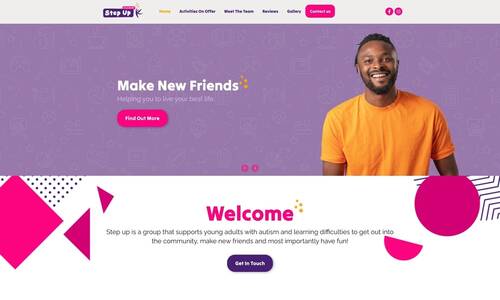How Website Design Affects User Experience and Customer Engagement
How Website Design Affects User Experience and Customer Engagement
Blog Article
Modern Website Design That Captures Interest and Converts
In an increasingly digital landscape, contemporary web site design has emerged as a critical consider recording individual interest and driving conversions. By purposefully utilizing visual pecking order, receptive formats, and involving interactive elements, developers can develop experiences that not only draw in visitors however also help with purposeful communications. Reliable call-to-action strategies play an essential role in assisting customers toward wanted end results. As we check out these vital components, it comes to be clear that understanding their interaction can considerably affect a site's performance and user contentment. What are the crucial elements that really make a difference?
Relevance of Visual Pecking Order
Aesthetic power structure is a critical aspect in web site layout, as it guides customers' attention and boosts their overall experience. By strategically organizing material, designers can direct customers to the most crucial information first, consequently boosting involvement and boosting use.
Including a logical circulation in content plan is essential; for example, positioning the most crucial info at the top of a web page cultivates instant recognition. Regular usage of typography, such as differing font sizes and styles, aids establish a clear content framework. This organization not just help in navigating but also constructs trust fund, as individuals feel much more comfortable when they can conveniently find what they are looking for.
Eventually, a well-executed aesthetic pecking order not just boosts aesthetic appeal however also substantially affects individual behavior. By focusing on necessary aspects and making certain a seamless experience, designers can effectively transform site visitors into clients, strengthening the significance of this foundational layout concept in contemporary website advancement.
Responsive Style for All Instruments
Creating a seamless experience across numerous devices is essential in today's electronic landscape, where individuals accessibility web sites from tablet computers, desktop computers, and mobile phones alike. Responsive design is a vital method that makes certain websites adapt fluidly to different screen positionings, sizes, and resolutions. By employing versatile grids, pictures, and CSS media inquiries, designers can create layouts that preserve visual stability and capability, no matter of the device being made use of.
The value of receptive style prolongs past visual appeals; it directly affects user interaction and conversion prices. An internet site that operates well on all tools urges longer check outs and lowers bounce rates, as customers are most likely to interact with material that is simple to browse. Moreover, search engines, especially Google, prioritize mobile-friendly sites in their positions, making responsive design a vital component of search engine optimization (SEARCH ENGINE OPTIMIZATION)
Integrating responsive style not just improves user experience however additionally improves the advancement procedure. By developing a single website that functions across gadgets, companies can save time and resources contrasted to creating different mobile and desktop versions. Inevitably, responsive style is a basic strategy for modern website layout, guaranteeing availability and satisfaction for all customers, despite their gadget.
Engaging Interactive Aspects
While a receptive layout prepares for a practical website, including interesting interactive elements is important for catching user interest and fostering deeper links. Website Design. Interactive aspects, such as animations, quizzes, and clickable infographics, see this page create a much more vibrant user experience, motivating site visitors to invest even more time on the site
Including interactive features can also guide users with complex details, making it simpler to absorb material. As an example, interactive sliders can show product variants, while ingrained videos can supply demos or testimonials that resonate more than fixed images or message. In addition, gamification techniques, like benefits for finishing jobs or engaging with content, can enhance individual inspiration and retention.
Efficient use of interactive elements not just enriches the user experience but can also lead to higher conversion rates. It is necessary to stabilize interactivity with performance; overly intricate functions may prevent site speed, negatively affecting customer fulfillment.
Streamlined Navigating Practices
Effective navigation is a cornerstone of any type of successful website, as it straight influences user experience and material accessibility. Structured navigating techniques guarantee that users can quickly situate information, boosting their communication with the site. A well-structured navigation menu need to be straightforward and intuitive, normally including a restricted number of primary categories to stay clear of overwhelming site visitors.
To achieve structured navigation, developers should focus on a hierarchical structure that logically arranges material. Carrying out breadcrumb tracks can supply individuals with context about their existing location within the website, permitting smooth backtracking. Additionally, utilizing drop-down food selections can efficiently preserve space while still providing access to subcategories.
Receptive style is critical, as navigating should be practical across all tools (Website Design). Mobile users, in certain, benefit from touch-friendly food selections and retractable sections that maintain functionality without jeopardizing visual appeals

Efficient Call-to-Action Techniques
A well-crafted call-to-action (CTA) is important for guiding users towards wanted results on a web site, as it urges them to involve with content or purchase. To optimize their performance, CTAs get redirected here must be clear, engaging, and purposefully put throughout the website.
First, use action-oriented language that interacts urgency or value, such as "Start," "Sign up with Currently," or "Case Your Price cut." This language not just motivates customers however likewise sets clear assumptions regarding the following steps.
2nd, consider layout aspects; CTAs need to stand out visually via contrasting shades, adequate whitespace, and popular positioning. A button that is simple to see and click boosts the possibility of customer interaction.
Furthermore, personalizing CTAs based upon customer actions or demographics can substantially enhance engagement. Customized messages reverberate much more with customers, driving greater conversion rates.

Verdict
These parts jointly boost individual experience, ensuring that visitors continue to be engaged and motivated to explore material further. By prioritizing these style principles, companies can considerably enhance customer retention and conversion prices, ultimately leading to greater success in the digital landscape.
In an increasingly electronic landscape, modern-day web site design has actually emerged as a pivotal factor in recording individual attention and driving conversions.Visual power structure is a crucial element in website layout, as it guides customers' attention and boosts their overall experience.The value of receptive layout extends past appearances; it directly impacts user interaction and conversion rates.Incorporating receptive design not just enhances individual experience however Get More Info likewise improves the development procedure. Ultimately, receptive layout is an essential method for contemporary website style, guaranteeing ease of access and contentment for all individuals, no matter of their gadget.
Report this page